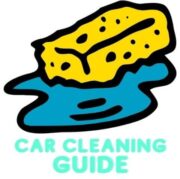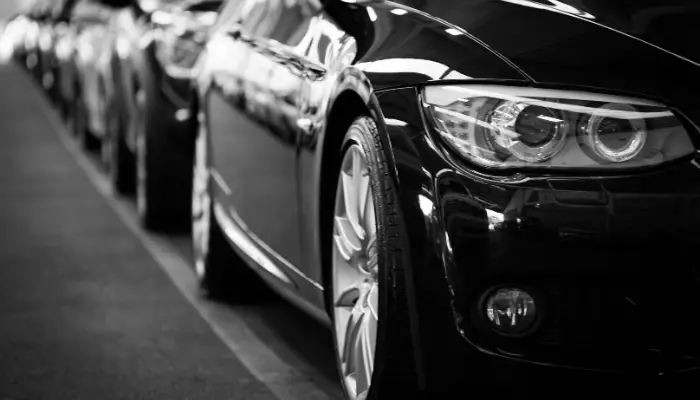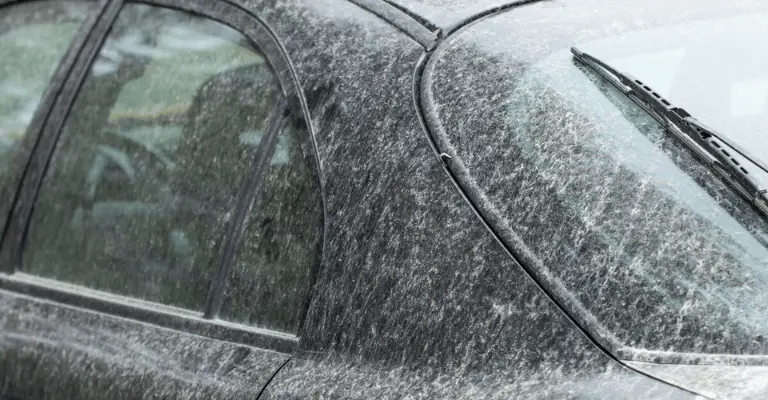Last Updated on October 14, 2023 by Chase Manhattan
Keeping your car shining and spotless is a task all car owners take pride in. However, water spots lurking on your car’s surface can take away its shine and become a persistent annoyance. These stubborn spots, often left behind by minerals in water, can affect your vehicle’s aesthetic appeal. Welcome to my exhaustive guide on ‘How to Prevent Water Spots on Your Car’.
This guide is designed to equip you with effective techniques and tips to maintain your car’s pristine appearance. Whether you’re a car enthusiast seeking to preserve your vehicle’s lustrous finish or a newbie looking to keep your car in top condition, this guide will serve as your go-to resource.
Let’s dive into the world of car care and bid a final goodbye to those pesky water spots.
- How to Clean Car Carpets Quick and Easy - July 10, 2024
- Can You Touch Up Clear Coat? Yes and No (Here’s Why) - November 25, 2023
- How To Wax A Car By Hand: A Comprehensive Guide - November 14, 2023
Quick Navigation
What are water spots?
Water spots are caused by the minerals found in water. When water evaporates from your car’s surface, it leaves behind these minerals, which form a ring on the paintwork. There are two types of water spots: type I water spots, which can be wiped off, and type II water spots, which have bonded with the paint and require more effort to remove.
Water spots can appear on any part of your car but are most commonly found on the windows, mirrors, and paintwork. They can range in color from white to brown, depending on the mineral content of the water.
[How to Remove Scratches from Black Plastic Bumpers]
Understanding what causes water spots on your car
Several factors contribute to the formation of water spots on your car. The most common cause is hard water, which contains high concentrations of minerals like calcium and magnesium. When this water evaporates, the minerals are left behind, forming a water spot.
Another contributing factor is rainwater. While we may think of rainwater as pure, it can contain pollutants and acids, which can leave spots when it evaporates. Additionally, if you park your car near a sprinkler or under a tree, the water droplets can dry on your car and leave spots.
Lastly, washing your car improperly can result in water spots. If you wash your car in direct sunlight, the water can evaporate too quickly, leaving behind minerals. Similarly, if you don’t dry your car thoroughly after washing, you may end up with water spots.
Read more: What is clear coat protectant?
Dangers of hard water spots on your car’s paint
Hard water spots are more than just a cosmetic issue. Over time, they can etch into your car’s paintwork, causing damage that can be costly to repair. This is because the minerals in hard water stains are abrasive and can gradually wear down the clear coat that protects your paintwork.
Additionally, if you use hard water to wash your car, it can leave a film on the surface. This film can dull the shine of your car and make it look dirty, even after you’ve just washed it. In severe cases, hard water spots can even cause rusting.
Furthermore, hard water spots on your windshield can impair your visibility, posing a safety risk. Therefore, it’s essential to understand the importance of preventing and promptly removing hard water spots from your car.
[Bubbling Car Paint and How To Treat and Prevent It]
Importance of thoroughly washing your car
To prevent water spots, it’s crucial to wash your car thoroughly. This full wash process not only removes dirt, grime, and contaminants that can contribute to water spots but also gives you a clean slate to apply protective measures.
Start by using a high-quality car wash soap. Avoid using household detergents, as they can strip away the protective wax layer and cause more harm than good. Wash your car in a shaded area to prevent the water from evaporating too quickly and leaving behind minerals.
Rinse your car thoroughly to remove all soap residue. Any soap left on the surface can attract dirt and cause water spots. Finally, dry your car immediately after washing to prevent the formation of water spots.
[DIY Car Wash Soap with Household Supplies That DON’T Strip Wax]
Techniques for drying your car after washing it
Proper drying techniques are crucial in preventing water spots. Start to avoid water spots by using a high-quality, absorbent microfiber towel. Avoid using regular bath towels, as they can scratch your car’s surface.
Gently pat dry your car, starting from the top and working your way down. Don’t rub or scrub, as this can cause scratches. Instead, let the towel absorb the water.
For hard-to-reach areas like mirrors and door handles, consider using a car dryer or a leaf blower. These tools can help remove water from these areas, preventing water spots.
Related read: How To Protect Car Paint
The role of a water filter in preventing water spots
Installing a water filter on your hose can significantly reduce the risk of water spots. A water filter can remove the minerals responsible for water spots, giving you cleaner, softer water to wash your car with.
Choose a filter that’s designed for car washing and can handle the water flow rate of your hose. Also, check the filter’s lifespan and ensure it’s easy to replace.
Using a water filter can also improve the effectiveness of your car wash soap and make it easier to rinse off, reducing the risk of soap residue and subsequent water spots.
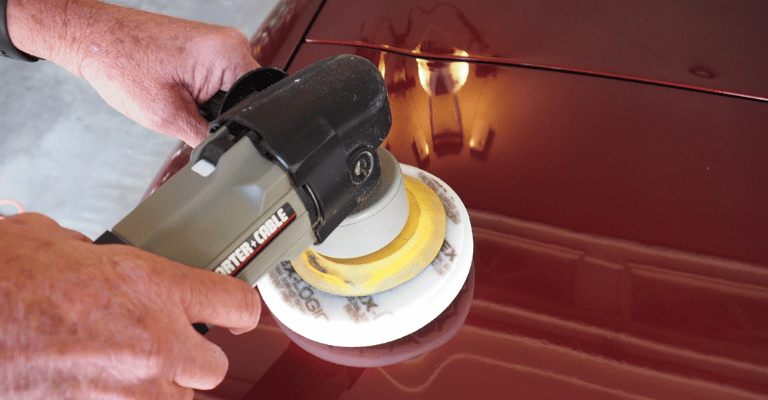
Waxing your car with a buffer to prevent water spots
Waxing your car regularly can provide a protective layer that helps prevent water spots. The wax provides a barrier between the water and your car’s paint, causing the water to bead up and roll off rather than evaporating on the surface.
Use a high-quality car wax and a buffer for the best results. Apply the wax in a thin, even layer, and use the buffer to gently buff it into the paintwork. This will not only protect your car but also enhance its shine.
Remember to wax your car in a shaded area and when the car’s surface is cool to touch. This will prevent the wax from drying too quickly and leaving residue.
Read more:
> How often to wax a car?
> Ceramic Coat vs Wax
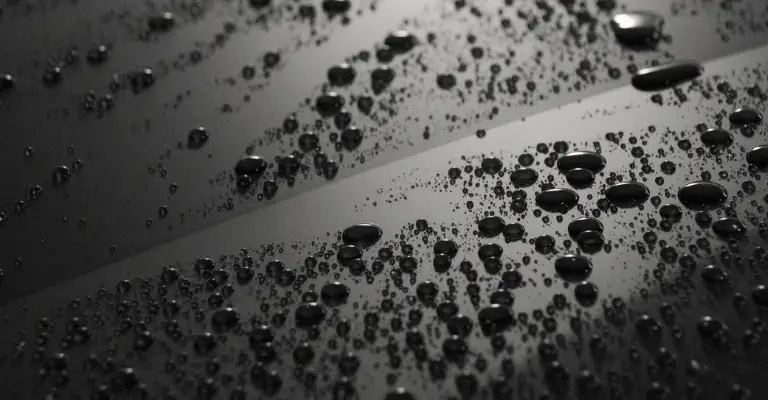
Applying a ceramic coating for protection against water spots
For long-term protection against water spots, consider applying a ceramic coating to your car. Ceramic coatings provide a hydrophobic layer that repels water, preventing it from drying on the surface and leaving spots.
However, applying a ceramic coating requires careful preparation and application. The car’s exterior surfaces must be thoroughly cleaned and decontaminated before the coating can be applied. Once applied, the coating needs time to cure.
While it’s possible to apply a ceramic coating yourself, you might want to consider having it professionally done to ensure the best results.
[Why is Ceramic Coating so Expensive?]
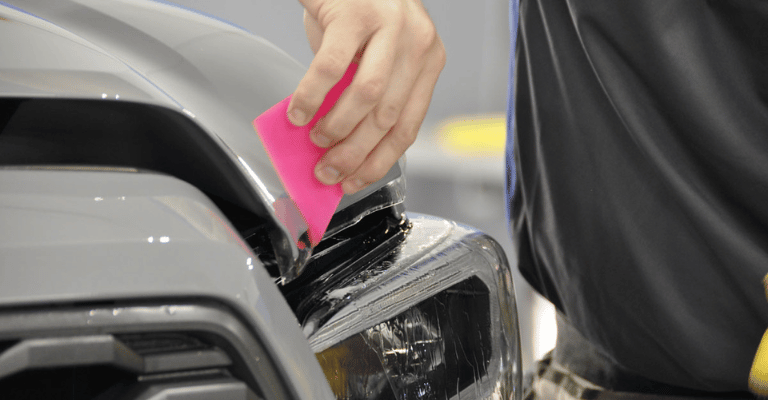
Installing paint protection film to guard your car
Another way to protect your car from water spots is by installing a paint protection film. This transparent film provides a physical barrier against water spots, as well as scratches and other damage.
Like ceramic coatings, paint protection films require careful installation. It’s best to have this done by a professional to ensure the film is applied correctly and without bubbles or wrinkles.
Once installed, the film requires minimal maintenance and can last for several years, making it a cost-effective solution for protecting your car from water spots.
[Pros & Cons of Paint Protection Film]
Choosing a quality car wash hose for optimal results
The hose you use to wash your car can also impact the risk of water spots. A quality car wash hose should have a gentle spray pattern that doesn’t cause the water to splash or mist, which can increase the risk of water spots.
Look for a hose with adjustable pressure and spray patterns. This allows you to customize the water flow to suit your needs and prevent water spots.
Additionally, consider a hose with a built-in water filter. This can provide an extra layer of protection against hard water spots.
[How to Wash A Car Without A Hose]
The benefits of drying your car with a blower
Drying your car with a blower can help prevent water spots by removing water from areas that towels can’t reach. This includes areas like mirrors, grilles, and door handles.
A car dryer or leaf blower can effectively remove water from your cars in these areas, preventing it from drying and leaving spots. Just be sure to use a blower with adjustable speed settings to prevent damage.
Remember to dry your car immediately after washing to minimize the risk of water spots.
[How to Get Vomit off Your Car’s Exterior]

Ensuring your car is completely dry: Best practices
To ensure your car is completely dry and free of water spots, follow these best practices:
- Use a high-quality, absorbent microfiber towel to pat dry your car.
- Use a car dryer or leaf blower to remove water from hard-to-reach areas.
- Check your car for any remaining water spots. If you find any, remove them with a car detailing spray and a microfiber cloth.
- Avoid washing your car in direct sunlight, which can cause the water to evaporate too quickly and leave spots.
- Consider using a water filter, wax, ceramic coating, or paint protection film for added protection against water spots.
Key takeaways to prevent water spots on your car
Water spots on your car are more than just a cosmetic issue. They can damage your paintwork, impair your visibility, and detract from your car’s overall appearance. Fortunately, with a little knowledge and the right techniques, you can prevent water spots and keep your car looking its best.
Start by understanding what causes water spots and the dangers of hard water spots. Then, ensure you’re washing and drying your car properly and using a water filter when necessary. Consider waxing your car, applying a ceramic coating, installing a paint protection film, and using a quality car wash hose for added protection.
FAQs and Related Questions
Why does my car get water spots so easily?
You may be not drying your car properly, or using a low-quality car wash hose that reacts to the water flowing through it. In some cases, you may be in a hard-water zone. You will need to use a hard water filtration system while rinsing your car.
Are water spots on a car permanent?
No, water spots are not permanent as long as they’re removed quickly – and prevented in the future. If left on a car’s paint, over time the water spots will develop into paint etching.
Does car wax prevent hard water spots?
Yes, car wax will help you prevent hard water spots because it creates a protective layer of wax between your paint’s surface and the exterior world.
